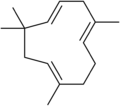Secondary metabolite
Secondary Metabolites are organic compounds that are not directly involved in the normal growth, development, or reproduction of an organism. Unlike primary metabolites, secondary metabolites often have a specific function in the plant or animal, such as defense against predators or pathogens, or communication with other organisms. They are often synthesized in response to specific environmental conditions or developmental stages.
Classification
Secondary metabolites can be classified into three main groups based on their biosynthetic origin: terpenes, phenolics, and nitrogen-containing compounds.
Terpenes
Terpenes are the largest group of secondary metabolites, consisting of over 40,000 known compounds. They are synthesized from five-carbon isoprene units and can range in size from monoterpenes (two isoprene units) to polyprenols (over 100 isoprene units).
Phenolics
Phenolics are compounds that contain one or more hydroxyl groups attached to an aromatic ring. They are synthesized from the amino acid phenylalanine and include a wide variety of compounds such as flavonoids, tannins, and lignins.
Nitrogen-containing compounds
Nitrogen-containing compounds include alkaloids, non-protein amino acids, and cyanogenic glycosides. They are synthesized from amino acids and often have potent biological activities.
Functions
Secondary metabolites have a wide range of functions in the organisms that produce them. Some common functions include:
- Defense against predators or pathogens
- Attraction of pollinators or seed dispersers
- Communication with other organisms
- Protection against UV radiation
- Regulation of plant growth and development
See also
References
Transform your life with W8MD's budget GLP-1 injections from $125.
W8MD offers a medical weight loss program to lose weight in Philadelphia. Our physician-supervised medical weight loss provides:
- Most insurances accepted or discounted self-pay rates. We will obtain insurance prior authorizations if needed.
- Generic GLP1 weight loss injections from $125 for the starting dose.
- Also offer prescription weight loss medications including Phentermine, Qsymia, Diethylpropion, Contrave etc.
NYC weight loss doctor appointments
Start your NYC weight loss journey today at our NYC medical weight loss and Philadelphia medical weight loss clinics.
- Call 718-946-5500 to lose weight in NYC or for medical weight loss in Philadelphia 215-676-2334.
- Tags:NYC medical weight loss, Philadelphia lose weight Zepbound NYC, Budget GLP1 weight loss injections, Wegovy Philadelphia, Wegovy NYC, Philadelphia medical weight loss, Brookly weight loss and Wegovy NYC
|
WikiMD's Wellness Encyclopedia |
| Let Food Be Thy Medicine Medicine Thy Food - Hippocrates |
Medical Disclaimer: WikiMD is not a substitute for professional medical advice. The information on WikiMD is provided as an information resource only, may be incorrect, outdated or misleading, and is not to be used or relied on for any diagnostic or treatment purposes. Please consult your health care provider before making any healthcare decisions or for guidance about a specific medical condition. WikiMD expressly disclaims responsibility, and shall have no liability, for any damages, loss, injury, or liability whatsoever suffered as a result of your reliance on the information contained in this site. By visiting this site you agree to the foregoing terms and conditions, which may from time to time be changed or supplemented by WikiMD. If you do not agree to the foregoing terms and conditions, you should not enter or use this site. See full disclaimer.
Credits:Most images are courtesy of Wikimedia commons, and templates, categories Wikipedia, licensed under CC BY SA or similar.
Contributors: Prab R. Tumpati, MD










